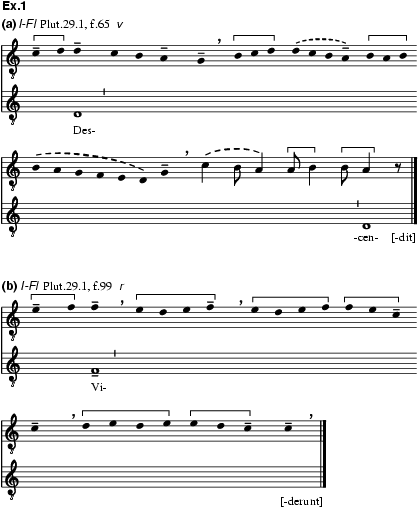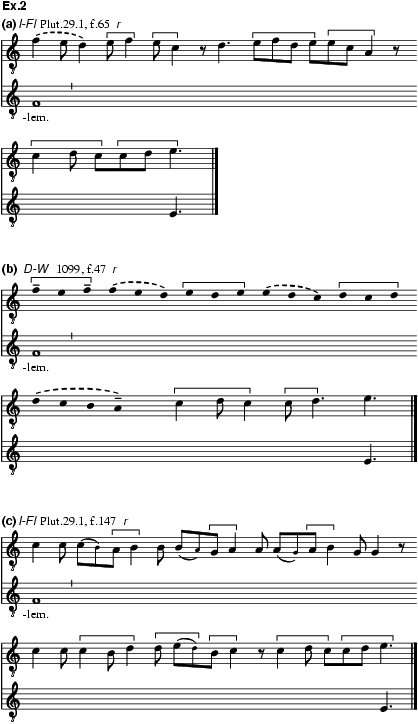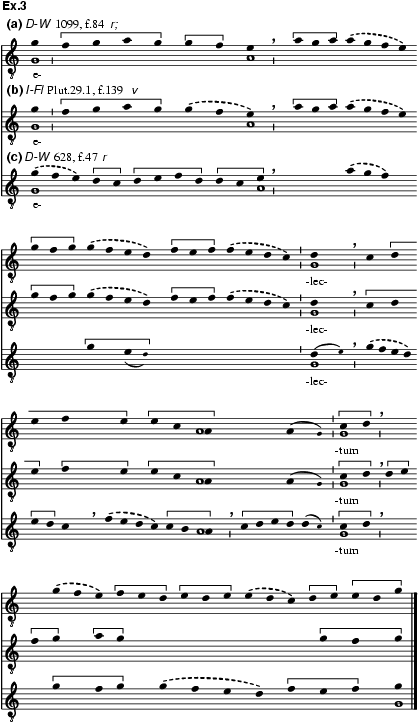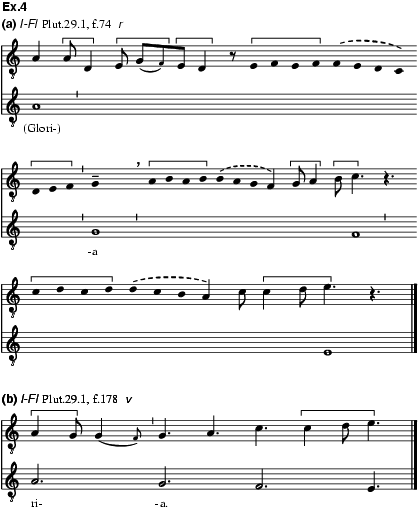
(Lat.: ‘great book’).
The name given to the repertory of liturgical polyphony (and some monophony) created at the Cathedral of Notre Dame in Paris during the second half of the 12th century and the first few decades of the 13th. The collection is mentioned by two music theorists: Johannes de Garlandia, who, in the version of his treatise included in the compilation of Hieronymus de Moravia (ed. S. Cserba, 1935, p.229), used the term ‘magnum volumen’; and Anonymous IV (ed. Reckow, 1967, i, 46), who referred to it as the ‘magnus liber organi de gradali et antifonario’ (‘the great collection of organum on the graduale and antiphonale’) and wrote that it was ‘made’ (‘fecit’) by Leoninus ‘to enhance the divine service’ (‘pro servitio divino multiplicando’). It was subsequently revised or ‘edited’ by Perotinus (‘qui abbreviavit eundem’), whose work included the creation of ‘many better clausulas’, or sections of larger organa. In this revised form it remained in use at Notre Dame up to Anonymous IV's own time, the end of the 13th century. This Parisian liber organi is thus less a book containing a specific collection of works than an evolving repertory with somewhat different material in each surviving manuscript.
The Magnus liber is perhaps the greatest single achievement in medieval music, whose historical significance resides above all in its being a written collection. Appearing at a time when most polyphony was improvised, or at least orally created and transmitted, it represents the beginnings of polyphonic ‘composition’ in the modern sense, and was the matrix in which the harmonic, contrapuntal and rhythmic aspects of European musical language were developed and normalized. The Magnus liber survives in several 13th-century manuscripts; numerous additional sources, now lost, are mentioned in medieval catalogues.
EDWARD ROESNER
Most scholars regard the Magnus liber organi as containing only two-voice organa. However, Anonymous IV made it clear that it was more comprehensive, and that ‘organum’ refers not to the genre of organum specifically, but rather to musica mensurabilis, polyphony in general, regardless of genre or the number of voices used. The Magnus liber described by Anonymous IV contained organum (settings of responsorial chant and a few other plainchant items) for two to four voices and conductus for one to four voices (Reckow, 1967, i, 46, 82); it is possible that Anonymous IV also understood the early motet to be represented, included among the new clausulas that formed part of Perotinus's revision of Leoninus's collection. It is likely that Leoninus and Perotinus both worked in a variety of genres and idioms, and composed for differing numbers of voices. It is unlikely that they were the only musicians involved in the creation of the Magnus liber, however: Anonymous IV mentioned the involvement of another figure, Robertus de Sabilone, and still others doubtless also contributed repertory or recast already existing works.
The surviving manuscript copies of the Magnus liber vary in the repertory and even the genres that they include, reflecting the changing character of the collection. Most sources do concur in the arrangement of the repertory, however. Thus the largest source, and the one with the closest ties to Notre Dame itself, I-Fl Plut.29.1 (hereafter F), begins with plainchant settings (organa and clausulas), continues with works with newly created texts, many of which have a less clearly defined place in the liturgy (conductus and motets), and concludes with a collection of refrain songs that are the most closely related of any of this music to the secular repertory. Within each group, the collection moves from pieces with more voices to those with fewer (organa quadrupla, tripla then dupla; conductus for three voices, then for two voices; then ‘conductus motets’ for three voices copied as though they were two-voice conductus, followed by motets for two voices copied as single lines; and finally monophonic conductus and solo refrain songs). Within the organum collections complete pieces precede separate clausulas (quadrupla, one four-voice clausula; tripla, three-voice clausulas; dupla, four cycles of two-voice clausulas), and within each of these collections the order follows the liturgical calendar (works for temporale and sanctorale feasts are fused into a single cycle; in the dupla and two-voice clausulas, Office and Mass organa appear in separate cycles, but in the relatively small collection of tripla, Office and Mass organa for the same feast appear together). The three-voice motets, all based on clausulas, are also arranged in liturgical sequence, suggesting that they constitute a clausula cycle of sorts in their own right; what determines their location in F (and hence the placement of the two-voice motets that follow them in the manuscript) is their layout on the page, which resembles that of the conductus that precede them. In the Magnus liber fragment DK-Kk 1810 4O, the motet Gaudeat devotio/Nostrum, included in F, appears in two-voice form as a clausula in the organum Alleluia, Pascha nostrum. The other large Magnus liber sources have somewhat different repertorial emphases but reveal the same overall principles of organization: D-W 628 (hereafter W1) includes only a handful of motets and transmits them as conductus; D-W 1099 (hereafter W2) concludes with four fascicles of motets, each divided into a series of alphabetically arranged collections, including two fascicles devoted to motets with French texts; and E-Mn 20486, after beginning with organa quadrupla, is dominated by conductus and Latin motets, most of them grouped together as though they belonged to the same genre.
The organa include settings of the solo portions of the gradual and alleluia of the Mass, the great responsories of the Office (the responsory sung at first Vespers and, on rare occasions, second Vespers, the third and sixth matins responsories and, often, the ninth, which frequently repeated the vespers responsory), responsories and antiphons sung during processions, and the Benedicamus domino at the close of Vespers and possibly other Offices as well. Organum was composed for the major feasts of the Parisian ecclesiastical calendar, the four annuale festivals of Christmas, Easter, Pentecost and the Assumption of the Blessed Virgin Mary, feasts of duplex rank, and feasts ranked as semiduplex and nine lessons. For the annuale feasts, polyphony was provided not only for the main festival but also for some of the days within the octave and for the octave itself. In their choice of chants and even in the details of the plainchant melodies themselves, the organa correspond to the liturgical practice of Notre Dame to a remarkable degree.
In a number of instances there is more than one setting of the same plainchant, even within the same copy of the Magnus liber. There are in F two organa for two voices and one for four of the gradual Viderunt omnes, for example. Some organa are contrafacta of other works: Perotinus's three-voice setting of Alleluia, Nativitas, for example, is also used for Alleluia, Diffusa est gratia, Alleluia, Iudicabunt sanctis and Alleluia, Sanctissime Iacobe, the first in F, the last two in W2. Alleluia, Post partum virgo, found only in F, is for the most part cobbled together from material taken from Alleluia, Assumpta est Maria and Alleluia, Per manus, preserved in one or another form in W1, F and W2. In many organa, shared material is less the result of deliberate borrowing than a consequence of the use of common property, of stock figures that recur from work to work. Thus the openings of the responsory Descendit de celis and the gradual Viderunt omnes are each found in numerous other compositions (ex.1), and stereotypical cadence gestures appear, disappear and replace each other, seemingly at the discretion of the scribes who compiled the manuscripts. Ex.2 gives three different endings for the same clausula on ‘Et Iherusalem’ from the responsory Iudea et Iherusalem. A large number of these formulae are collected in the ‘Vatican organum treatise’ (I-Rvat Ottob. lat.3025), in which the melodic and contrapuntal language of the Magnus liber is presented in synthesis, probably to facilitate the creation of new organa.


Within the ‘same’ organum, there are likely to be striking differences from copy to copy. In Alleluia, Assumpta est Maria, for example, F differs from W1 and the related setting in W2 on ‘Alleluia’ and the beginning of ‘Assumpta est’, for the rest of which the three move into and out of agreement; F and W2 share the same discant clausula on ‘Maria’, while W1 has organum purum, and so on; throughout this organum, W1 is largely in organum purum while F and W2 include significantly more (if not always the same) discant clausulas. In many instances, seemingly unrelated settings are actually different elaborations of the same underlying polyphonic structure, as in ex.3, from Alleluia, Posui adiutorium. Looking at the organum collection as a whole, each manuscript can be shown to have its own distinctive musical character, reflecting the aesthetic sensibilities and preferences of the particular composers, singers and scribes who were instrumental in shaping and transmitting it.

All of this underscores the constant revision sustained by the Magnus liber throughout its history, described by Anonymous IV as a ‘revision’ (abbreviatio) by Perotinus. One aspect of this entailed making organum purum more like discant. The organa were conceived in modal notation, which permits organum purum melismas in particular to flow in an unconstrained, rhythmically free, less than precisely measured fashion. The scribes of W2, D-Bs lat. 4O 523 and DK-Kk 1810 4O copied the organa in mensural notation of one kind or another, thereby imposing precise measure (and in some cases rhythmic designs that were foreign to the original style) on the organum purum melismas and, in effect, yoking them into a consistent metrical structure. Another aspect of the recasting involved actual abbreviation: in some manuscripts, the organum purum melismas are shortened or eliminated, as in the organa tripla in F-MOf H196 and the organa dupla in D-Bs 4O 523. Moreover, the clausula collections in F include two cycles of tiny snippets of rather simple polyphony, one for Office organa, the other for Mass settings (154 pieces in all), that can be used to replace much longer sections of organum purum and thereby effect a similar reduction in the overall scale of an organum (ex.4). The majority of the 462 independent two-voice clausulas in F and the 102 similar works in W1 are, however, like the clausulas for three and four voices, substantial, sophisticated discant compositions, many of which explore and extend the possibilities inherent in modal rhythm. These are polyphonic treatments of plainchant segments that are also set as discant in the larger organa; without question, their primary function was as replacements for pre-existing discant, in many cases extending rather than shortening the work, and thus they probably bear witness to the ‘many better clausulas’ cited by Anonymous IV in connection with Perotinus's recasting activity. For example, the first three clausulas in F are all discant settings of the chant segment ‘et Iherusalem’ from Iudea et Iherusalem; the first is also found in the F and W2 copies of the Iudea et Iherusalem organum (but with different cadence formulae; see ex.2), the second is found in the W1 copy of the organum, and the third is unique to the F clausula cycle.

Analysing the different stages of work in the Magnus liber has proved a difficult task. Even the pieces in the F clausula cycles are not necessarily all ‘revisions’ of earlier settings; many were probably salvaged from organa that were being reworked, and some doubtless came from alternative organum compositions on the same plainchant. Ludwig (1909, 1910) believed that each different copy of the Magnus liber preserves a distinct stage in the history of the collection, W1 transmitting the organa of Leoninus and Perotinus's clausulas, F containing the music of Perotinus in its most comprehensive state and W2 representing a subsequent stage in the evolution of the collection. However, this is too simplistic, since all the sources are significantly later than the repertory they transmit and each is the product of compilation from a number of exemplars (Roesner, 1981). Husmann (1962, 1963) suggested that the organa in the three major sources reflect various stages in the development of the Magnus liber in a somewhat different way, arguing that the pieces common to W1, W2 and F represent an original layer that began to appear at the time of the inception of work on Notre Dame in 1163, and that the organa found only in F and W2 were created after the consecration of the new cathedral's high altar in 1182, while works common to F and W1 and those unique to F constitute still later layers of creative activity, much of it at Paris churches other than Notre Dame. This view is no longer accepted, however (Wright, 1989, chap.7). It has always been assumed that the Magnus liber was created for the new cathedral, yet while this seems a reasonable hypothesis, especially in view of the appropriateness of the organum style to the spatial and acoustical environment of Notre Dame, it is not impossible that the origins of this idiom extend back to a period before the construction of this Gothic edifice began. Moreover, each of the three major organum sources has its own liturgical character, reflecting more the intent of its compiler than its place in the chronology of the Magnus liber: the large collection in F includes polyphony for both Matins and Vespers, as well as for processions and the ferial days within the octaves of the annuale feasts; W2 includes no polyphony for Matins specifically, for days within the octave or for processions, and it subsumes within a commune sanctorum section numerous organa that are assigned in F to specific saints; W1 also omits most organa specifically for Matins, most processions and the days within the octave, except for the second day within the octave of annuale feasts. F and W2 provide polyphony for the ‘Gloria Patri’ section of responsory organa and, often, for the repeat of the respond in both Office and Mass organa; these sections are not included in the W1 copies of the corresponding organa, undoubtedly reflecting a difference in local performing practice.
Several manuscripts contain what appear to be supplements to the Magnus liber, collections that bring the established Parisian repertory into line with local practices. These include the organa tripla transmitted in the fragment CH-Bu FX37 and the conductus, organa and clausulas in the ‘St Victor’ manuscript F-Pn lat.15139, both sources evidently reflecting Parisian liturgical traditions in the decades after the principal repertory had ceased to grow, and the cycle of organa for Marian masses in the last fascicle of W1, which clearly reflects insular liturgical customs. Although the Magnus liber orginated at the secular cathedral of Paris, it achieved a wide dissemination and was used in a variety of institutions. W1 was copied for the Augustinian cathedral priory of St Andrews in Scotland, and E-Mn 20486 was written in Spain, possibly for Toledo Cathedral. Other manuscripts confirm the presence of the Magnus liber in the English Benedictine cathedral of Worcester, the Spanish Benedictine monastery of S Domingo de Silos, the royal Cistercian nunnery of Las Huelgas, Burgos, and the French cathedral of Beauvais, as well as at Dominican houses in present-day Germany and Poland. From library catalogues and archives we know that the Parisian liber organi was used at St Paul's Cathedral, London, and in the royal chapels of Henry III and Edward I of England, and probably in the chapel of Charles V of France in the later 14th century; one copy, which bore some resemblance to F, was in the treasury of Pope Boniface VIII in the early 14th century, and there is also evidence of the presence of the Notre Dame repertory in Italian Franciscan convents at the time. The music of the Magnus liber circulated throughout Europe, the first music to do so since the dissemination of Gregorian chant in the Carolingian domains four centuries earlier. As a ‘classic’ repertory, an ars antiqua, it was the point of departure for numerous local repertories and emerging styles, not only in France, but also in England and Italy.
See also Discant, §I, 3; Organum, §§8–10; Leoninus; Perotinus; Sources, MS, §IV, 4.
F. Ludwig: ‘Die liturgischen Organa Leonins und Perotins’, Riemann-Festschrift (Leipzig, 1909/R), 200–13
F. Ludwig: Repertorium organorum recentioris et motetorum vetustissimi stili, i/1 (Halle, 1910/R)
J. Handschin: ‘Zur Geschichte von Notre Dame’, AcM, iv (1932), 5–17, 49–55
S.M. Cserba, ed.: Hieronymus de Moravia O.P.: Tractatus de musica (Regensburg, 1935)
H. Husmann: ‘Die Offiziumsorgana der Notre Dame-Zeit’, JbMP 1935, 31–49
H. Husmann, ed.: Die drei- und vierstimmigen Notre-Dame-Organa: kritische Gesamtausgabe, Publikationen älterer Musik, xi (Leipzig, 1940/R)
W.G. Waite: The Rhythm of Twelfth-Century Polyphony: its Theory and Practice (New Haven, CT, 1954)
F. Zaminer: Der vatikanische Organum-Traktat (Ottob. lat.3025): Organum-Praxis der frühen Notre Dame-Schule und ihrer Vorstufen (Tutzing, 1959)
W.G. Waite: ‘The Abbreviation of the Magnus Liber’, JAMS, xiv (1961), 147–58
H. Husmann: ‘St. Germain und Notre-Dame’, Natalicia musicologica Knud Jeppesen … oblata, ed. B. Hjelnborg and S. Sørensen (Copenhagen, 1962), 31–6
H. Husmann: ‘Ein dreistimmiges Organum aus Sens unter den Notre-Dame-Kompositionen’, Festschrift Friedrich Blume, ed. A.A. Abert and W. Pfannkuch (Kassel,1963), 200–03
H. Husmann: ‘The Enlargement of the Magnus Liber Organi and the Paris Churches St. Germain l’Auxerrois and Ste. Geneviève-du-Mont’, JAMS, xvi (1963), 176–203
H. Husmann: ‘The Origin and Destination of the Magnus Liber Organi’, MQ, xlix (1963), 311–30
K. von Fischer: ‘Neue Quellen zur Musik des 13., 14. und 15. Jahrhunderts’, AcM, xxxvi (1964), 79–97
N.E. Smith: The Clausulae of the Notre Dame School: a Repertorial Study (diss., Yale U.,1964)
N.E. Smith: ‘Tenor Repetition in the Notre Dame Organa’, JAMS, xix (1966), 329–51
F. Reckow, ed.: Der Musiktraktat des Anonymus 4 (Wiesbaden, 1967)
H. Tischler: ‘The Arrangements of the Gloria patri in the Office Organa of the Magnus liber organi’, Festschrift Bruno Stäblein, ed. M. Ruhnke (Kassel, 1967), 260–65
R. Flotzinger: Der Discantussatz im Magnus liber und seiner Nachfolge (Vienna, 1969)
N.E. Smith: ‘Interrelationships among the Alleluias of the Magnus liber organi’,JAMS, xxv (1972), 175–202
F. Reckow: ‘Das Organum’, Gattungen der Musik in Einzeldarstellungen: Gedenkschrift Leo Schrade, ed. W. Arlt and others (Berne, 1973), 434–96
N.E. Smith: ‘Interrelationships among the Graduals of the Magnus liber organi’,AcM, xlv (1973), 73–97
W. Arlt and M. Haas: ‘Pariser modale Mehrstimmigkeit in einem Fragment der Basler Universitätsbibliothek’, Forum musicologicum, i (1975), 223–72
H. Tischler: ‘Zwei End-Responde im Magnus Liber’, Mf, xxviii (1975), 247–60
P. Jeffery: ‘Notre-Dame Polyphony in the Library of Pope Boniface VIII’, JAMS, xxxii (1979), 118–24
E.H. Roesner: ‘The Performance of Parisian Organum’, EMc, vii (1979), 174–89
G.A. Anderson, ed.: Notre-Dame and Related Conductus: Opera omnia (Henryville, PA, 1979–86)
R. Falck: The Notre Dame Conductus: a Study of the Repertory (Henryville, PA, 1981)
E.H. Roesner: ‘The Problem of Chronology in the Transmission of Organum Duplum’, Music in Medieval and Early Modern Europe: Patronage, Sources, and Texts, ed. I. Fenlon (Cambridge, 1981), 365–90
M. Huglo: ‘Les débuts de la polyphonie à Paris: les premiers organa parisiens’, Forum musicologicum, iii (1982), 93–163
H. Tischler: ‘The Evolution of the Magnus liber organi’, MQ, lxx (1984), 163–74
C. Wright: ‘The Feast of the Reception of the Relics at Notre Dame of Paris’ Music and Context: Essays for John M. Ward, ed. A.D. Shapiro and P. Benjamin (Cambridge, MA, 1985), 1–13
R.A. Baltzer: ‘Notre Dame Manuscripts and their Owners: Lost and Found’, JM, v (1987), 380–99
J. Bergsagel: ‘The Transmission of Notre Dame Organa in Some Newly Discovered “Magnus liber organi” Fragments in Copenhagen’, IMSCR XIV: Bologna 1987, 629–36
R.A. Baltzer: ‘Another Look at a Composite Office and its History: the Feast of Susception reliquarum in Medieval Paris’, JRMA, cxiii (1988), 1–27
H. Tischler, ed.: The Parisian Two-Part Organa: the Complete Comparative Edition (Stuyvesant, NY, 1988)
H. van der Werf: Integrated Directory of Organa, Clausulae, and Motets of the Thirteenth Century (Rochester, NY, 1989)
C. Wright: Music and Ceremony at Notre Dame of Paris, 500–1550 (Cambridge, MA, 1989)
R.A. Baltzer: ‘How Long was Notre-Dame Organum Performed?’, Beyond the Moon: Festschrift Luther Dittmer, ed. B. Gillingham and P. Merkley (Ottawa, 1990), 118–43
H. van der Werf: Anonymous IV as Chronicler (Rochester, NY, 1990); repr. in Musicology Australia, xv (1992), 3–25 [with response by E.H. Roesner]
R.A. Baltzer: ‘The Geography of the Liturgy at Notre-Dame of Paris’, Plainsong in the Age of Polyphony, ed. T.F. Kelly (Cambridge, 1992), 45–64
E.H. Roesner, ed.: Les quadrupla et tripla de Paris, Le magnus liber organi de Notre-Dame de Paris, i (Les Remparts, 1993)
R.A. Baltzer, ed.: Les clausules à deux voix du manuscrit de Florence, Biblioteca Medicea-Laurenziana, pluteus 29.1, fascicule V, Le magnus liber organi de Notre-Dame de Paris, v (Les Remparts, 1995)
T.B. Payne, ed.: Les organa à deux voix du manuscrit de Wolfenbüttel, Herzog August Bibliothek, cod. Guelf. 1099 Helmst., Le magnus liber organi de Notre-Dame de Paris, vi (Les Remparts, 1996)
For further bibliography see Organum and discant: bibliography.